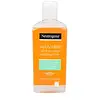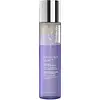What's inside
What's inside
 Key Ingredients
Key Ingredients

 Benefits
Benefits

 Concerns
Concerns

 Ingredients Side-by-side
Ingredients Side-by-side

Water
Skin ConditioningGlycerin
HumectantButylene Glycol
HumectantPolysorbate 20
EmulsifyingC12-15 Alkyl Lactate
EmollientLactic Acid
BufferingPanthenol
Skin ConditioningSalicylic Acid
MaskingCocamidopropyl Pg-Dimonium Chloride Phosphate
Sodium Chloride
MaskingDisodium EDTA
Tetrahydroxypropyl Ethylenediamine
Citric Acid
BufferingHydroxyacetophenone
AntioxidantBenzalkonium Chloride
AntimicrobialPhenoxyethanol
PreservativeParfum
MaskingWater, Glycerin, Butylene Glycol, Polysorbate 20, C12-15 Alkyl Lactate, Lactic Acid, Panthenol, Salicylic Acid, Cocamidopropyl Pg-Dimonium Chloride Phosphate, Sodium Chloride, Disodium EDTA, Tetrahydroxypropyl Ethylenediamine, Citric Acid, Hydroxyacetophenone, Benzalkonium Chloride, Phenoxyethanol, Parfum
Water
Skin ConditioningDimethicone
EmollientSqualane
EmollientHexylene Glycol
EmulsifyingButylene Glycol
HumectantSodium Chloride
MaskingGlycerin
HumectantSodium Hyaluronate
HumectantMyristyl Nicotinate
Skin ConditioningGlycyrrhiza Uralensis Root Extract
Skin ConditioningDaucus Carota Sativa Root Extract
Skin ConditioningRice Amino Acids
Skin ConditioningDiglucosyl Gallic Acid
Beta-Carotene
Skin ConditioningJania Rubens Extract
Skin ConditioningGlycine Soja Oil
EmollientBoswellia Serrata Gum
MaskingMandelic Acid
AntimicrobialLeuconostoc/Radish Root Ferment Filtrate
AntimicrobialMalic Acid
BufferingSodium Carrageenan
Emulsion StabilisingLactic Acid
BufferingBacillus/Sea Salt Ferment Filtrate
Skin ConditioningDisodium EDTA
Honey
HumectantSalicylic Acid
MaskingAminomethyl Propanol
BufferingCitric Acid
BufferingEthylhexylglycerin
Skin ConditioningTocopherol
AntioxidantDipropylene Glycol
HumectantPentylene Glycol
Skin ConditioningParfum
MaskingCetrimonium Chloride
AntimicrobialPhenoxyethanol
PreservativeBenzoic Acid
MaskingBenzyl Benzoate
AntimicrobialGeraniol
PerfumingBenzyl Salicylate
PerfumingCitronellol
PerfumingCitral
PerfumingLimonene
PerfumingLinalool
PerfumingBenzyl Alcohol
PerfumingCI 42090
Cosmetic ColorantCI 17200
Cosmetic ColorantWater, Dimethicone, Squalane, Hexylene Glycol, Butylene Glycol, Sodium Chloride, Glycerin, Sodium Hyaluronate, Myristyl Nicotinate, Glycyrrhiza Uralensis Root Extract, Daucus Carota Sativa Root Extract, Rice Amino Acids, Diglucosyl Gallic Acid, Beta-Carotene, Jania Rubens Extract, Glycine Soja Oil, Boswellia Serrata Gum, Mandelic Acid, Leuconostoc/Radish Root Ferment Filtrate, Malic Acid, Sodium Carrageenan, Lactic Acid, Bacillus/Sea Salt Ferment Filtrate, Disodium EDTA, Honey, Salicylic Acid, Aminomethyl Propanol, Citric Acid, Ethylhexylglycerin, Tocopherol, Dipropylene Glycol, Pentylene Glycol, Parfum, Cetrimonium Chloride, Phenoxyethanol, Benzoic Acid, Benzyl Benzoate, Geraniol, Benzyl Salicylate, Citronellol, Citral, Limonene, Linalool, Benzyl Alcohol, CI 42090, CI 17200
Ingredients Explained
These ingredients are found in both products.
Ingredients higher up in an ingredient list are typically present in a larger amount.
Butylene Glycol (or BG) is used within cosmetic products for a few different reasons:
Overall, Butylene Glycol is a safe and well-rounded ingredient that works well with other ingredients.
Though this ingredient works well with most skin types, some people with sensitive skin may experience a reaction such as allergic rashes, closed comedones, or itchiness.
Learn more about Butylene GlycolCitric Acid is an alpha hydroxy acid (AHA) naturally found in citrus fruits like oranges, lemons, and limes.
Like other AHAs, citric acid can exfoliate skin by breaking down the bonds that hold dead skin cells together. This helps reveal smoother and brighter skin underneath.
However, this exfoliating effect only happens at high concentrations (20%) which can be hard to find in cosmetic products.
Due to this, citric acid is usually included in small amounts as a pH adjuster. This helps keep products slightly more acidic and compatible with skin's natural pH.
In skincare formulas, citric acid can:
While it can provide some skin benefits, research shows lactic acid and glycolic acid are generally more effective and less irritating exfoliants.
Most citric acid used in skincare today is made by fermenting sugars (usually from molasses). This synthetic version is identical to the natural citrus form but easier to stabilize and use in formulations.
Read more about some other popular AHA's here:
Learn more about Citric AcidDisodium EDTA plays a role in making products more stable by aiding other preservatives.
It is a chelating agent, meaning it neutralizes metal ions that may be found in a product.
Disodium EDTA is a salt of edetic acid and is found to be safe in cosmetic ingredients.
Learn more about Disodium EDTAGlycerin is already naturally found in your skin. It helps moisturize and protect your skin.
A study from 2016 found glycerin to be more effective as a humectant than AHAs and hyaluronic acid.
As a humectant, it helps the skin stay hydrated by pulling moisture to your skin. The low molecular weight of glycerin allows it to pull moisture into the deeper layers of your skin.
Hydrated skin improves your skin barrier; Your skin barrier helps protect against irritants and bacteria.
Glycerin has also been found to have antimicrobial and antiviral properties. Due to these properties, glycerin is often used in wound and burn treatments.
In cosmetics, glycerin is usually derived from plants such as soybean or palm. However, it can also be sourced from animals, such as tallow or animal fat.
This ingredient is organic, colorless, odorless, and non-toxic.
Glycerin is the name for this ingredient in American English. British English uses Glycerol/Glycerine.
Learn more about GlycerinLactic Acid is another well-loved alpha hydroxy acid (AHA). It is gentler than glycolic acid but still highly effective.
Its main role is to exfoliate the surface of the skin by loosening the “glue” that holds dead skin cells together. Shedding those old cells leads to smoother, softer, and more even-toned skin.
Because lactic acid molecules are larger than glycolic acid, they don’t penetrate as deeply. This means they’re less likely to sting or irritate, making it a great choice for beginners or those with sensitive skin.
Like glycolic acid, it can:
Lactic acid also acts as a humectant (like hyaluronic acid). It can draw water into the skin to improve hydration and also plays a role in the skin's natural moisturizing factor (NMF) in the form of sodium lactate.
Studies show it can boost ceramide production to strengthen the skin barrier and even help balance the skin’s microbiome.
To get results, choose products with a pH between 3-4.
Lower strengths (5-12%) focus on surface exfoliation; higher strengths (12% and up) can reach deeper in the dermis (deeper, supportive layer) to improve skin texture and firmness over time.
Though it was originally derived from milk, most modern lactic acid used in skincare is vegan. It is made through non-dairy fermentation to create a bio-identical and stable form suitable for all formulations.
When lactic acid shows up near the end of an ingredient list, it usually means the brand added just a tiny amount to adjust the product’s pH.
Legend has it that Cleopatra used to bathe in sour milk to help reduce wrinkles.
Lactic acid is truly a gentle multitasker: it exfoliates, hydrates, strengthens, and brightens. It's a great ingredient for giving your skin a smooth, glowing, and healthy look without the harshness of stronger acids.
Read more about some other popular AHA's here:
Learn more about Lactic AcidParfum is a catch-all term for an ingredient or more that is used to give a scent to products.
Also called "fragrance", this ingredient can be a blend of hundreds of chemicals or plant oils. This means every product with "fragrance" or "parfum" in the ingredients list is a different mixture.
For instance, Habanolide is a proprietary trade name for a specific aroma chemical. When used as a fragrance ingredient in cosmetics, most aroma chemicals fall under the broad labeling category of “FRAGRANCE” or “PARFUM” according to EU and US regulations.
The term 'parfum' or 'fragrance' is not regulated in many countries. In many cases, it is up to the brand to define this term.
For instance, many brands choose to label themselves as "fragrance-free" because they are not using synthetic fragrances. However, their products may still contain ingredients such as essential oils that are considered a fragrance by INCI standards.
One example is Calendula flower extract. Calendula is an essential oil that still imparts a scent or 'fragrance'.
Depending on the blend, the ingredients in the mixture can cause allergies and sensitivities on the skin. Some ingredients that are known EU allergens include linalool and citronellol.
Parfum can also be used to mask or cover an unpleasant scent.
The bottom line is: not all fragrances/parfum/ingredients are created equally. If you are worried about fragrances, we recommend taking a closer look at an ingredient. And of course, we always recommend speaking with a professional.
Learn more about ParfumPhenoxyethanol is a preservative that has germicide, antimicrobial, and aromatic properties. Studies show that phenoxyethanol can prevent microbial growth. By itself, it has a scent that is similar to that of a rose.
It's often used in formulations along with Caprylyl Glycol to preserve the shelf life of products.
Salicylic Acid (also known as beta hydroxy acid or BHA) is a well-known ingredient for treating skin that struggles with acne and clogged pores. It exfoliates both the skin's surface and deep within the pores to help clear out buildup, control oil, and reduce inflammation.
Unlike AHAs (alpha hydroxy acids), salicylic acid is oil-soluble. This allows it to penetrate into pores which makes it especially effective for treating blackheads and preventing future breakouts.
Salicylic acid is also known for its soothing properties. It has a similar structure to aspirin and can calm inflamed or irritated skin, making it a good option for acne-prone skin that is also sensitive.
Concentrations of 0.5-2% are recognized by the U.S. FDA as an over-the-counter topical acne product.
It can cause irritation and/or dryness if one's skin already has a compromised moisture barrier, so it's best to focus on repairing that before introducing this ingredient into your routine.
While salicylic acid does not increase sun sensitivity, it’s still important to wear sunscreen daily to protect your skin.
If you are looking for the ingredient called BHA or Butylated Hydroxyanisole, click here.
Learn more about Salicylic AcidChances are, you eat sodium chloride every day. Sodium Chloride is also known as table salt.
This ingredient has many purposes in skincare: thickener, emulsifier, and exfoliator.
You'll most likely find this ingredient in cleansers where it is used to create a gel-like texture. As an emulsifier, it also prevents ingredients from separating.
There is much debate on whether this ingredient is comedogenic. The short answer - comedogenic ratings don't tell the whole story. Learn more about comegodenic ratings here.
The concensus about this ingredient causing acne seems to be divided. Research is needed to understand if this ingredient does cause acne.
Scrubs may use salt as the primary exfoliating ingredient.
Learn more about Sodium ChlorideWater. It's the most common cosmetic ingredient of all. You'll usually see it at the top of ingredient lists, meaning that it makes up the largest part of the product.
So why is it so popular? Water most often acts as a solvent - this means that it helps dissolve other ingredients into the formulation.
You'll also recognize water as that liquid we all need to stay alive. If you see this, drink a glass of water. Stay hydrated!
Learn more about Water